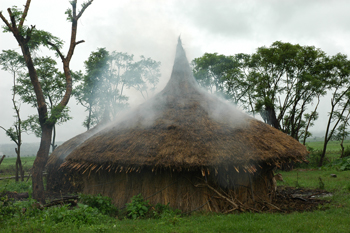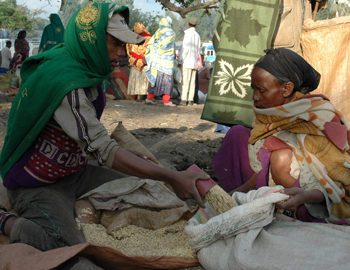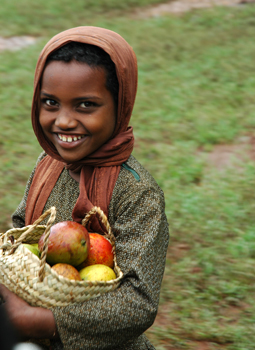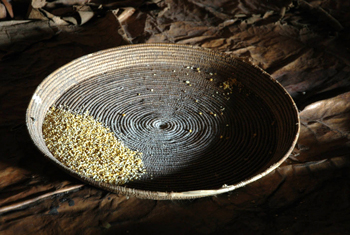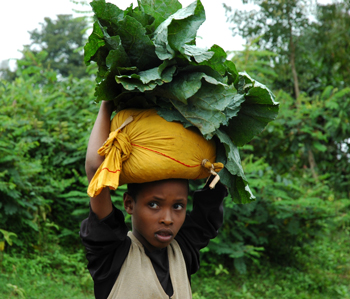| Support for Ethiopia’s 85 million smallholder farmers. | |
|
The situation is beginning to improve in some areas where rainfall has been received. However, the full recovery of lost assets and future agricultural productivity will require sustained support from government and humanitarian partners in the areas of seed support, supply of veterinary drugs and training of veterinary staff. The rate of livestock sickness in Somali Region has reached critical levels in pastoral communities. NGOs in the region are carrying out small-scale slaughter destocking exercises to improve access to water and pasture for core breeding stock. Ethiopia’s State Minister for Agriculture and Rural Development, Dr Abera Deresa, says drought emergencies like this one, which the Ethiopian Government and United Nations agencies agree are affecting pockets of Ethiopia’s most vulnerable peoples and marginal farming areas, are a common, recurrent phenomenon in Ethiopia. ‘What is being under-reported’, says the minister, ‘is that Ethiopia’s farm production has recently been increasing by a healthy 10% every year. Unfortunately, this doesn’t necessarily mean that demand and supply are compatible. Thus we have the current food crisis in Ethiopia, which is caused (as in the rest of the world) by climate change (drought), the international shift of food crops to biofuel, and incompatibility of demand and supply.’ The Ethiopian government has been working closely with humanitarian organizations to mobilize timely humanitarian support for the worst-affected regions and peoples. In this work, Abera said, Ethiopia relied on an Early Warning System set up within the Ministry of Agriculture and Rural Development. Aid programs are responding to this and other crises. The United States, for example, will this year give Ethiopia more than US$800 million—$460 million for food, $350 million for HIV/AIDS treatment, and just $7 million for agricultural development. No one wants a repeat of the great Ethiopian famine of 1984/5, which killed a million people. ‘We need to help countries like Ethiopia to create and sustain livelihoods as well as to save lives, says Carlos Seré, director general of the International Livestock Research Institute (ILRI), which has a principal campus in Ethiopia’s capital, Addis Ababa. ‘That requires something longer term than food aid. It requires helping the country build skills, infrastructure and policy instruments that support equitable development of smallholder agriculture, the backbone of the Ethiopia’s economy. Pastoralists and small-scale farmers should to be able to feed their families while building assets for the future.’ The Ethiopian Government agrees. Realizing that humanitarian support is not a long-term solution to the country’s food security problems, it is working to help its farmers improve and sustain their food production by, for example, improved ways of managing the country’s heavy clay Vertisol soils and controlling invasive weeds and termites in crop fields. The Government is also supporting market-oriented development of smallholder farmers at all levels, in recent years training some 60,000 extension workers who work directly with farmers. ‘The Government works closely with a wide variety of partners,’ says the minister. ‘One good example is the IPMS Project.’ Seré and Abera agree that development work should be homegrown wherever possible. That’s why in 2005 ILRI teamed up with the Ethiopian Ministry of Agriculture and Rural Development and the Ethiopian Agricultural Research System and other centres of the Consultative Group on International Agricultural Research (CGIAR) to implement an action-oriented research project to “Improving the Productivity and Market Success” (IPMS) of Ethiopian Farmers. This 5-year project, funded by the Canadian International Development Agency (CIDA), works on market-led agricultural development in ten pilot learning districts as well as at regional and federal levels.
(http://www.ipms-ethiopia.org/)
This initiative works to help smallholder farmers transform their subsistence-based farming Knowledge management, innovation capacity development and participatory commodity development approaches are cornerstones of the strategy. Both crop and livestock commodities are considered in the project’s 10 pilot learning districts, The rising price of food Can poor farmers benefit from rising prices? Even so, ILRI and its Ethiopian partners are well aware that not all small farmers will benefit from the rising prices of livestock commodities, that not all small farmers will enter the market economy—or should try, and that provision in policies should be made for those farmers who for various reasons will continue their subsistence production methods and those who will drop out of farming altogether.
Related Information: |

